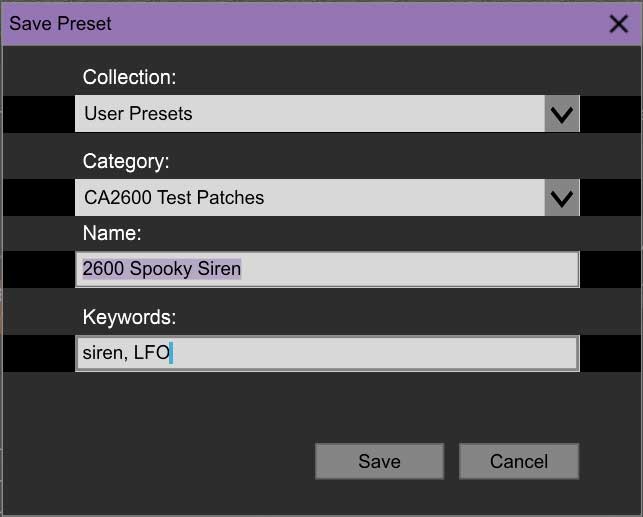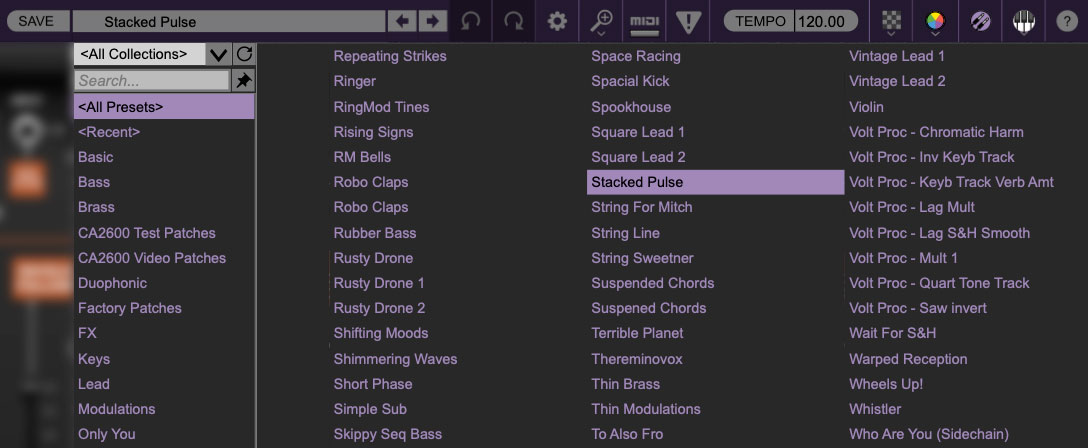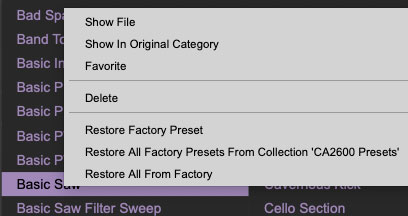
The purple strip at the top of the CA2600 interface is where you’ll load, save, and create sound presets. It also contains utility functions such as undo, redo, UI zoom and Focus controls, under-the-hood settings, and more. Let’s go over them:
New- Opens a new blank patch preset. By default, if an unsaved patch is currently open or you’ve modified an existing saved patch, a dialog asks if you’d like to save the patch in its current state. This greatly reduces the possibility of losing an edited unsaved patch. (This can be disabled by disabling the checkbox Settings>Interface>"Ask To Save Presets.")

Save- Use this to save patches. There are a couple of levels of hierarchy:
Collection- This is the top level of organization, and contains entire “sets” of presets. The CA2600 Presets are the main included collection. We also include a User Presets Collection for storing your own presets, but you’re free to create your own collections. To create a new collections, click in the Collection text field (where it says User Presets above) and type a name. User-created sounds can be freely saved to any collection; we like to keep ‘em separated for organizational purposes.
Categories- Within each Collection are a number of sound categories. As with collections, you’re free to create as many categories as you like. To create a category, click in the Category text field of the Save dialog window and type a new category name.
Patch- A patch is an individual sound. To save a patch, simply type the name in the Name field and click Save.
Keywords- Descriptive words such as “huge,” “noisy,” “poly,” etc., can be added to patches to make them appear when terms are typed in the Search field. Use commas to separate multiple keywords entries.

Browsing Patches- Patches can be browsed by clicking the <Select Preset> field. To select a preset collection, click in the area that says <All Collections> or on the downward-facing arrow next to it.
Clicking on the left-side categories narrows down which patches are displayed.
<All Presets> will show presets from all collections and categories.
<Recent> displays recently used presets.
Refresh- This is the circular arrow button to the right of the downward arrow; clicking this checks the Cherry Audio server for new or updated presets.

Pin - Clicking the push-pin icon locks the patch selection list open, allowing fast and easy browsing and auditioning of patches. Click the icon again to disable pin mode. when in pin mode, the up and down arrow keys can be used to select patches.
Preset- Step Back/Forward Arrows- These step to the previous or next preset. macOS [⌘+left/right arrow key] or Windows [CTRL+left/right arrow key] will navigate through presets back and forth in the currently selected collection/category.
Undo/Redo- These circular arrows will undo or redo the last action. It remembers many steps, so if you really loused something up, keep on clickin'...
Settings- This is where user preferences for user interface, audio interfaces, user account, and more are configured. See the Settings section for full information.

Importing Presets with drag-and-drop
Presets can be imported singly or en masse (as a single compressed ZIP file) simply by dragging and dropping from the desktop anywhere on the user interface.
If a single .*preset file is dragged and dropped, the sound is immediately loaded and the standard Save Preset dialog appears; this lets you save the sound to the instrument's preset browser. Note that you don't have to save the sound to preset browser; if you just want to hear and play the sound, click the Cancel button in the Save Preset dialog - the sound will still be loaded.
Compressed zip files containing multiple sounds can also be drag and dropped onto the UI. This works the same as with single sounds, but instead of the Save Preset dialog, you'll see the Import Preset Collection dialog. The presets will be added as a new collection and available in the categories for which they were tagged.
Zoom Magnifying Glass- Click to resize the CA2600 interface. Selecting 100% returns the user interface to native size.
MIDI Tab- Opens the MIDI controllers tab for configuring internal and hardware MIDI controls. See the MIDI Controllers Setup and MIDI Tab section for full information.
! (MIDI Panic) - Click to send an all-notes-off message in case of, "why won't this thing stop making noise?!?" stuck-note incidents. If that doesn't shut it up, check the Initial Gain slider in the Voltage Controlled Amplifier section (toward the right, near the top). If that doesn't work, try turning down the Mast Vol at the top right. If THAT doesn't work... try kicking it?
Tempo (Standalone Version Only)- Displays CA2600’s current internal tempo setting. CA2600's internal tempo affects the Sample & Hold, Low Frequency Oscillator, and Delay sections when their corresponding Sync buttons are toggled. The tempo setting can be changed by moving the mouse up and down anywhere in the tempo section, or by double-clicking the number and entering the desired BPM value.
The tempo display only appears in the standalone version of CA2600. VST, AU, and AAX plug-in versions receive tempo data from their host DAW app.
Cable Transparency- Clicking the checkerboard icon displays the cable transparency slider. Slide this to the left for more transparent cables, or to the right for more opaque cables.
Cable Color Select- Click this to select the global cable color, i.e. the color of any newly patched cable. Clicking Random randomly chooses a color for each new cable.
Show/Hide Cables- Clicking this hides or shows all cables. It has no effect on sounds, and its status does not save with patches. Cables can also be shown or hidden using the key shortcuts [CONTROL-D] (PC) or [⌘-D] (Mac).
Special Cool Cable Color Select Feature- The color of any existing cable can be changed by right-clicking in jack area. Right-clicking on a jack that doesn’t have a cable plugged in will change the global cable color (i.e. the same as changing the color with the toolbar button).

QWERTY Musical Typing Keyboard- Opens an onscreen keyboard allowing a standard QWERTY computer keyboard to be used for playing music notes. For more information, see QWERTY Musical Typing Keyboard (MTK) section.

Help - Clicking this launches your web browser and opens the help document you’re currently reading. This some serious circular logic when you think about it.
CA2600 logo (lower-right corner, it's huge, how could you miss it?)- This isn't really in the top toolbar, but clicking this displays “about” information, and shows the version number and current registered user ID.
Focus Button

Since the original 2600 is beastly large, and maybe your computer display isn't, the UI can potentially be hard to see. With this in mind, the Focus button conveniently blows up the user interface to roughly twice its normal size within the current window size. Unlike the Zoom "magnifying glass" function, Focus doesn't affect the current window size. By default, the patch panel section fills the current window, but the view can be scrolled vertically and horizontally with a mouse wheel, track pad, or Apple Mighty Mouse finger-scrolling. Or if you're the last person on earth still using a single-button mouse, scroll bars will appear at the window edges when in Focus mode. (Drop us a line from that hotmail.com email account, umkay?)
Using Focus mode couldn't be easier - just click the Focus button the top menu bar. To return to standard view, click Reset. There's also a superfast key shortcut - on Mac, hold the ⌘ [COMMAND] key and click the mouse; in Windows, hold the [OPTION] key and click the mouse. Focus can be reset with the same key shortcuts.
Preset List Right-Click Functions

Show File- This displays the selected preset in the Mac or Windows folder containing it. This is useful for backing up or sending a preset file to another user.
Show In Original Category- Selects the preset within its category, i.e. the category will highlight in the left preset menu. The Show In Original Category command only displays if the preset was selected within the <All Presets>, <Favorites>, or <Recent> categories.
Favorites- Favorited presets will show in when the <Favorites> category is selected. A star will display next to the preset name. Right-click on the preset and reselect Favorite to un-favorite it.
Delete- Deletes the selected preset.
Restore Factory Preset- If one of the factory (i.e. not user) patches is edited and saved, selecting this command restores the patch to its unaltered "factory" setting. This menu will be grayed-out for user bank patches.
Restore All Factory Presets From 'CA2600 Presets'- If any patches from the "factory" CA2600 bank are edited and saved, selecting this command restores all of them to their unaltered "factory" setting.
Restore All From Factory- If any patches from the "factory" banks are edited and saved, selecting this command restores all of them to their unaltered "factory" setting. At the time of writing, the CA2600 bank mentioned above is the only factory bank, so this function and the Restore All Factory Presets From 'CA2600 Presets' above have the same effect.